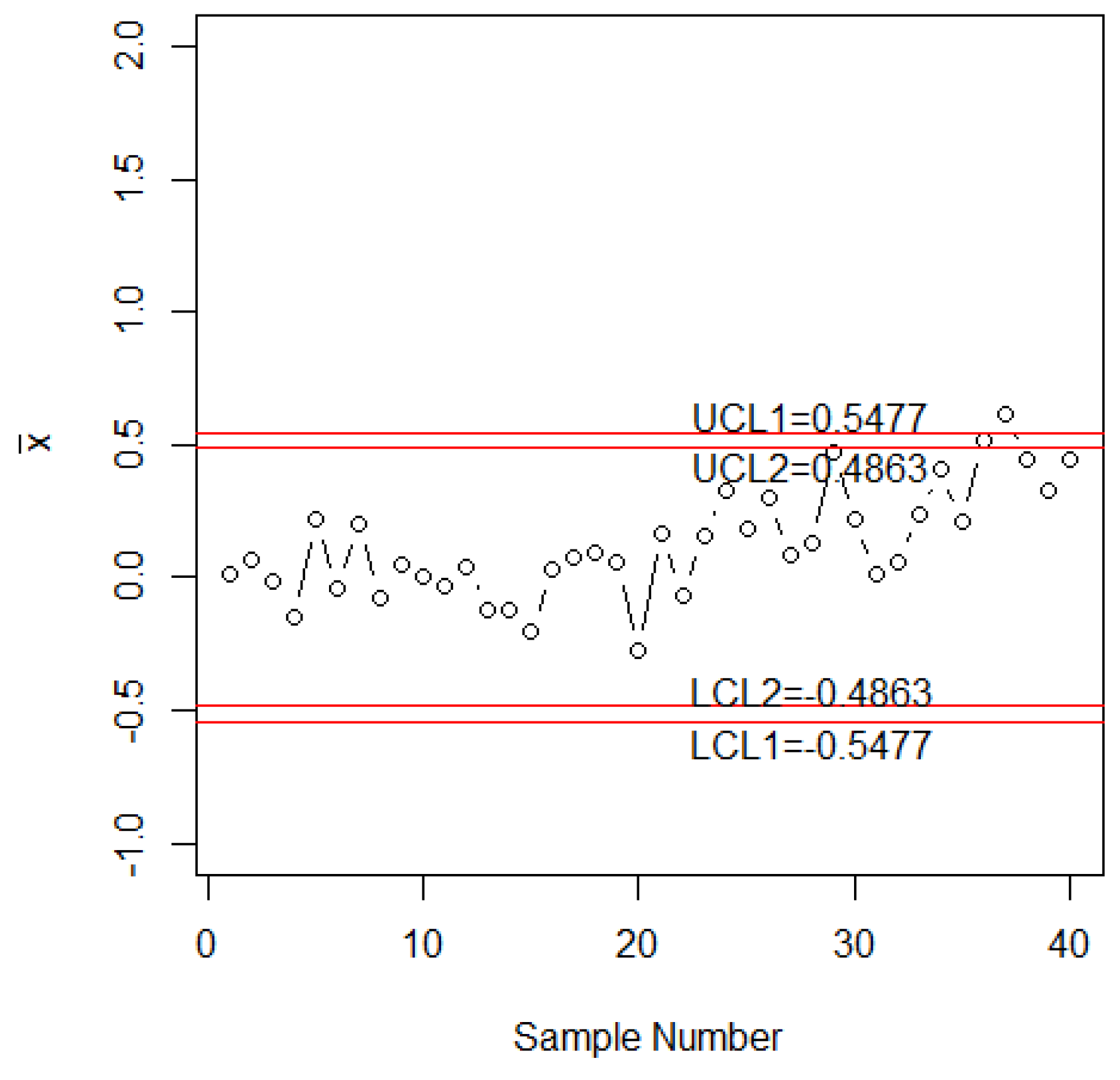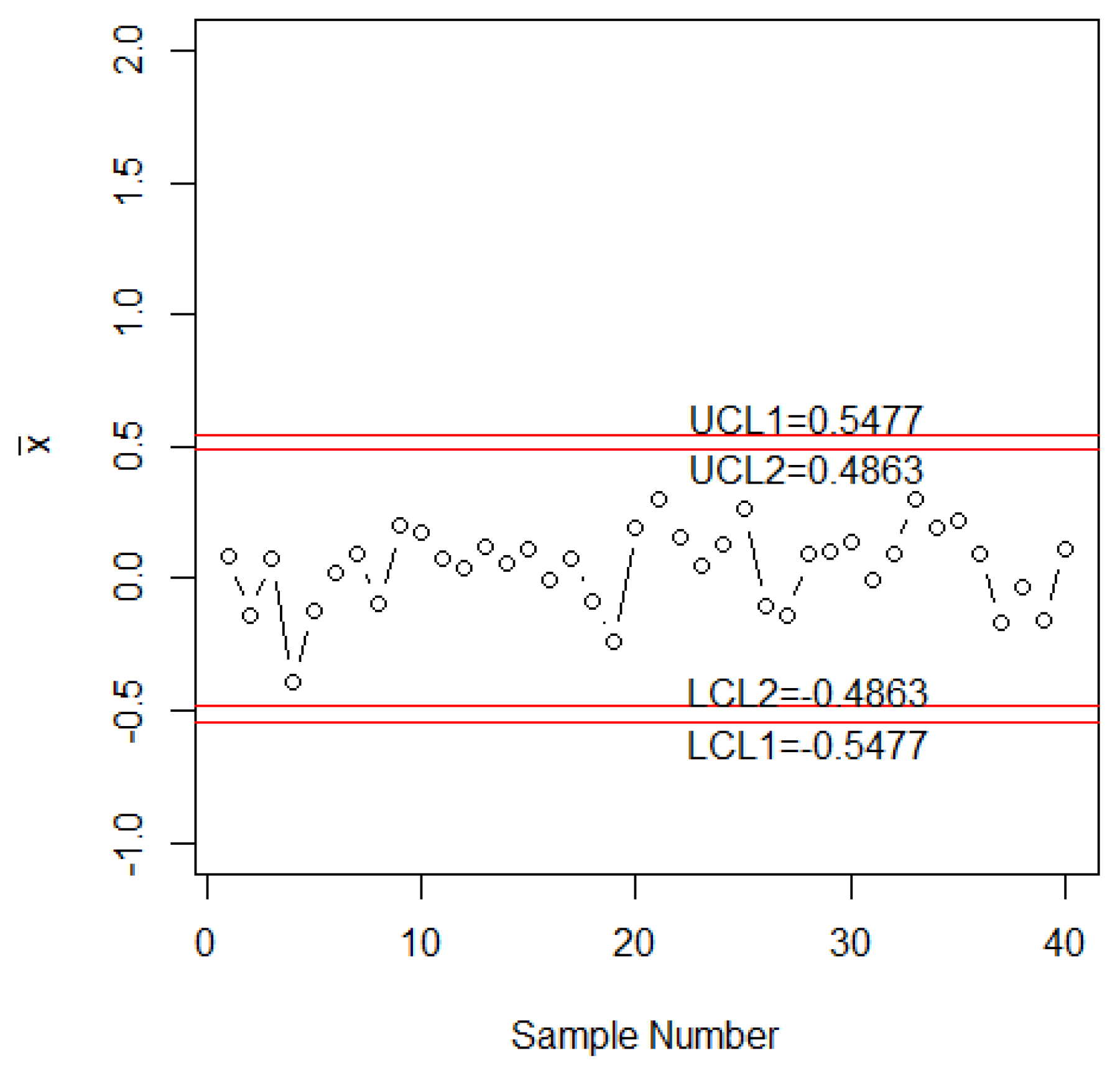Design of a New Variable Shewhart Control Chart Using Multiple Dependent State Repetitive Sampling
Abstract
:1. Introduction
2. Design of Proposed Chart
2.1. Measures for in-Control Process
2.2. Measures for Out-of-Control Process
- For fixed values of all other parameters, decreases as increases from 2 to 3.
- For fixed values of all other parameters, decreases as increases from 300 to 370.
3. Advantages of Proposed Chart
4. Industrial Application
5. Concluding Remarks
Author Contributions
Funding
Acknowledgments
Conflicts of Interest
References
- Shewhart, W.A. Statistical Method from the Viewpoint of Quality Control; Courier Corporation: North Chelmsford, MA, USA, 1939. [Google Scholar]
- Montgomery, D.C. Introduction to Statistical Quality Control; John Wiley & Sons: Hoboken, NJ, USA, 2017. [Google Scholar]
- Al-Oraini, H.; Rahim, M.A. Economic statistical design of X control charts for systems with Gamma (λ, 2) in-control times. Comput. Ind. Eng. 2002, 43, 645–654. [Google Scholar]
- Costa, A.F. X charts with variable sample size. J. Qual. Technol. 1994, 26, 155–163. [Google Scholar] [CrossRef]
- Chakraborti, S. Run length, average run length and false alarm rate of Shewhart X-bar chart: Exact derivations by conditioning. Commun. Stat. Simul. Comput. 2000, 29, 61–81. [Google Scholar] [CrossRef]
- Chen, G.; Cheng, S.W.; Xie, H. Monitoring process mean and variability with one EWMA chart. J. Qual. Technol. 2001, 33, 223–233. [Google Scholar] [CrossRef]
- He, D.; Grigoryan, A.; Sigh, M. Design of double-and triple-sampling X-bar control charts using genetic algorithms. Int. J. Prod. Res. 2002, 40, 1387–1404. [Google Scholar] [CrossRef]
- Baud-Lavigne, B.; Bassetto, S.; Penz, B. A broader view of the economic design of the X-bar chart in the semiconductor industry. Int. J. Prod. Res. 2010, 48, 5843–5857. [Google Scholar] [CrossRef]
- Safaei, A.S.; Kazemzadeh, R.B.; Niaki, S.T.A. Multi-objective economic statistical design of X-bar control chart considering Taguchi loss function. Int. J. Adv. Manuf. Technol. 2012, 59, 1091–1101. [Google Scholar] [CrossRef]
- LUPO, T. Economic-statistical design approach for a vssi X-bar chart considering taguchi loss function and random process shifts. Int. J. Reliab. Qual. Saf. Eng. 2014, 21, 1450006. [Google Scholar] [CrossRef]
- De Araújo Rodrigues, A.A.; Epprecht, E.K.; De Magalhães, M.S. Double-sampling control charts for attributes. J. Appl. Stat. 2011, 38, 87–112. [Google Scholar] [CrossRef]
- Aslam, M.; Khan, N.; Azam, M.; Jun, C.-H. Designing of a new monitoring t-chart using repetitive sampling. Inf. Sci. 2014, 269, 210–216. [Google Scholar] [CrossRef]
- Aslam, M.; Azam, M.; Jun, C.-H. A control chart for an exponential distribution using multiple dependent state sampling. Qual. Quant. 2014, 49, 455–462. [Google Scholar] [CrossRef]
- Aslam, M.; Nazir, A.; Jun, C.-H. A new attribute control chart using multiple dependent state sampling. Trans. Inst. Meas. Control 2014, 37. [Google Scholar] [CrossRef]
- Yen, F.Y.; Chong, K.M.B.; Ha, L.M. Synthetic-type control charts for time-between-events monitoring. PLoS ONE 2013, 8, e65440. [Google Scholar] [CrossRef] [PubMed]
- Abujiya, M.A.R.; Riaz, M.; Lee, M.H. Enhanced cumulative sum charts for monitoring process dispersion. PLoS ONE 2015, 10, e0124520. [Google Scholar] [CrossRef] [PubMed]
- Azam, M.; Aslam, M.; Jun, C.-H. Designing of a hybrid exponentially weighted moving average control chart using repetitive sampling. Int. J. Adv. Manuf. Technol. 2015, 77, 1927–1933. [Google Scholar] [CrossRef]
- Aslam, M.; Azam, M.; Jun, C.-H. New attributes and variables control charts under repetitive sampling. Ind. Eng. Manag. Syst. 2014, 13, 101–106. [Google Scholar] [CrossRef]
- Aslam, M.; Yen, C.-H.; Chang, C.-H.; Jun, C.-H. Multiple states repetitive group sampling plans with process loss consideration. Appl. Math. Model. 2013, 37, 9063–9075. [Google Scholar] [CrossRef]
- Aslam, M.; Khan, N.; Jun, C.-H. A Multiple Dependent State Control Chart Based on Double Control Limits. Research. J. Appl. Sci. Eng. Technol. 2014, 7, 4490–4493. [Google Scholar]



| k1 | 2.9352 | 2.9352 | 2.9352 | 2.9352 | 2.9352 | 2.9352 |
| k2 | 2.7865 | 2.7833 | 2.7919 | 2.7812 | 2.5991 | 2.6161 |
| n | 5 | 10 | 20 | 30 | 40 | 50 |
| c | ARL1 | |||||
| 0 | 300.00 | 300.00 | 300.01 | 300.00 | 300.00 | 300.00 |
| 0.01 | 288.30 | 282.96 | 277.10 | 269.77 | 225.11 | 222.28 |
| 0.02 | 276.24 | 265.44 | 253.13 | 239.19 | 175.50 | 170.96 |
| 0.05 | 239.51 | 213.87 | 184.82 | 159.02 | 94.43 | 88.13 |
| 0.1 | 182.86 | 143.06 | 103.74 | 78.02 | 41.06 | 35.77 |
| 0.15 | 137.06 | 94.69 | 58.83 | 39.95 | 20.27 | 16.70 |
| 0.2 | 102.38 | 63.35 | 34.61 | 21.78 | 10.98 | 8.72 |
| 0.25 | 76.79 | 43.17 | 21.24 | 12.66 | 6.48 | 5.05 |
| 0.3 | 58.06 | 30.04 | 13.61 | 7.84 | 4.14 | 3.22 |
| 0.4 | 34.18 | 15.51 | 6.33 | 3.60 | 2.12 | 1.71 |
| 0.5 | 21.00 | 8.72 | 3.46 | 2.07 | 1.40 | 1.22 |
| 0.6 | 13.47 | 5.32 | 2.19 | 1.44 | 1.13 | 1.05 |
| 0.7 | 9.01 | 3.52 | 1.58 | 1.17 | 1.03 | 1.01 |
| 0.8 | 6.28 | 2.50 | 1.28 | 1.06 | 1.01 | 1.00 |
| 0.9 | 4.56 | 1.90 | 1.12 | 1.02 | 1.00 | 1.00 |
| 1 | 3.44 | 1.54 | 1.05 | 1.00 | 1.00 | 1.00 |
| k1 | 2.9352 | 2.9352 | 2.9352 | 2.9352 | 2.9352 | 2.9352 |
| k2 | 2.7467 | 2.7797 | 2.7912 | 2.7145 | 2.5794 | 2.6090 |
| n | 5 | 10 | 20 | 30 | 40 | 50 |
| c | ARL1 | |||||
| 0 | 300.00 | 300.00 | 300.00 | 300.00 | 300.00 | 300.00 |
| 0.01 | 284.79 | 282.54 | 276.98 | 257.00 | 220.62 | 220.58 |
| 0.02 | 269.85 | 264.70 | 252.95 | 219.69 | 170.06 | 168.94 |
| 0.05 | 227.73 | 212.66 | 184.57 | 137.75 | 90.35 | 86.70 |
| 0.1 | 169.13 | 141.91 | 103.57 | 66.37 | 39.26 | 35.20 |
| 0.15 | 125.11 | 93.86 | 58.73 | 34.30 | 19.47 | 16.47 |
| 0.2 | 92.98 | 62.80 | 34.56 | 18.98 | 10.60 | 8.62 |
| 0.25 | 69.70 | 42.81 | 21.21 | 11.20 | 6.29 | 5.00 |
| 0.3 | 52.78 | 29.80 | 13.59 | 7.04 | 4.04 | 3.20 |
| 0.4 | 31.27 | 15.41 | 6.33 | 3.33 | 2.08 | 1.70 |
| 0.5 | 19.35 | 8.67 | 3.46 | 1.96 | 1.39 | 1.22 |
| 0.6 | 12.50 | 5.30 | 2.19 | 1.40 | 1.13 | 1.05 |
| 0.7 | 8.42 | 3.50 | 1.58 | 1.15 | 1.03 | 1.01 |
| 0.8 | 5.92 | 2.49 | 1.28 | 1.05 | 1.01 | 1.00 |
| 0.9 | 4.32 | 1.90 | 1.12 | 1.01 | 1.00 | 1.00 |
| 1 | 3.28 | 1.54 | 1.05 | 1.00 | 1.00 | 1.00 |
| k1 | 2.9996 | 2.9996 | 2.9996 | 2.9996 | 2.9996 | 2.9997 |
| k2 | 2.7784 | 2.7951 | 2.7591 | 2.7491 | 2.7632 | 2.6391 |
| n | 5 | 10 | 20 | 30 | 40 | 50 |
| c | ARL1 | |||||
| 0 | 370.00 | 370.00 | 370.00 | 370.00 | 370.00 | 370.00 |
| 0.01 | 346.38 | 339.78 | 319.86 | 307.08 | 302.49 | 257.71 |
| 0.02 | 324.14 | 311.40 | 277.17 | 256.48 | 248.23 | 191.57 |
| 0.05 | 265.41 | 238.15 | 183.39 | 154.64 | 141.26 | 94.73 |
| 0.1 | 190.88 | 152.18 | 97.22 | 72.72 | 60.63 | 37.77 |
| 0.15 | 138.65 | 98.79 | 54.57 | 37.16 | 28.76 | 17.49 |
| 0.2 | 101.93 | 65.54 | 32.17 | 20.38 | 14.92 | 9.07 |
| 0.25 | 75.87 | 44.47 | 19.85 | 11.93 | 8.43 | 5.21 |
| 0.3 | 57.16 | 30.87 | 12.79 | 7.44 | 5.17 | 3.31 |
| 0.4 | 33.60 | 15.88 | 6.03 | 3.47 | 2.45 | 1.74 |
| 0.5 | 20.66 | 8.90 | 3.33 | 2.02 | 1.53 | 1.23 |
| 0.6 | 13.26 | 5.42 | 2.13 | 1.42 | 1.18 | 1.06 |
| 0.7 | 8.89 | 3.57 | 1.55 | 1.16 | 1.05 | 1.01 |
| 0.8 | 6.20 | 2.53 | 1.26 | 1.05 | 1.01 | 1.00 |
| 0.9 | 4.51 | 1.92 | 1.11 | 1.01 | 1.00 | 1.00 |
| 1 | 3.40 | 1.55 | 1.05 | 1.00 | 1.00 | 1.00 |
| k1 | 2.9996 | 2.9996 | 2.9996 | 2.9997 | 2.9997 | 2.9997 |
| k2 | 2.7569 | 2.7578 | 2.7089 | 2.6637 | 2.5650 | 2.5805 |
| n | 5 | 10 | 20 | 30 | 40 | 50 |
| c | ARL1 | |||||
| 0 | 370.00 | 370.00 | 370.00 | 370.00 | 370.00 | 370.00 |
| 0.01 | 343.64 | 333.49 | 308.33 | 284.36 | 245.12 | 239.94 |
| 0.02 | 319.36 | 300.96 | 260.24 | 226.10 | 178.94 | 172.41 |
| 0.05 | 257.47 | 223.12 | 165.07 | 127.63 | 89.32 | 82.64 |
| 0.1 | 182.55 | 139.49 | 86.02 | 59.17 | 38.12 | 33.10 |
| 0.15 | 131.80 | 90.09 | 48.43 | 30.66 | 18.92 | 15.58 |
| 0.2 | 96.70 | 59.84 | 28.78 | 17.14 | 10.34 | 8.22 |
| 0.25 | 71.98 | 40.76 | 17.92 | 10.23 | 6.15 | 4.80 |
| 0.3 | 54.28 | 28.42 | 11.66 | 6.51 | 3.97 | 3.10 |
| 0.4 | 32.02 | 14.77 | 5.59 | 3.14 | 2.06 | 1.67 |
| 0.5 | 19.76 | 8.36 | 3.14 | 1.89 | 1.38 | 1.20 |
| 0.6 | 12.74 | 5.13 | 2.04 | 1.36 | 1.12 | 1.05 |
| 0.7 | 8.57 | 3.41 | 1.51 | 1.14 | 1.03 | 1.01 |
| 0.8 | 6.01 | 2.44 | 1.24 | 1.04 | 1.01 | 1.00 |
| 0.9 | 4.38 | 1.87 | 1.10 | 1.01 | 1.00 | 1.00 |
| 1 | 3.32 | 1.52 | 1.04 | 1.00 | 1.00 | 1.00 |
© 2018 by the authors. Licensee MDPI, Basel, Switzerland. This article is an open access article distributed under the terms and conditions of the Creative Commons Attribution (CC BY) license (http://creativecommons.org/licenses/by/4.0/).
Share and Cite
Aldosari, M.S.; Aslam, M.; Khan, N.; Jun, C.-H. Design of a New Variable Shewhart Control Chart Using Multiple Dependent State Repetitive Sampling. Symmetry 2018, 10, 641. https://doi.org/10.3390/sym10110641
Aldosari MS, Aslam M, Khan N, Jun C-H. Design of a New Variable Shewhart Control Chart Using Multiple Dependent State Repetitive Sampling. Symmetry. 2018; 10(11):641. https://doi.org/10.3390/sym10110641
Chicago/Turabian StyleAldosari, Mansour Sattam, Muhammad Aslam, Nasrullah Khan, and Chi-Hyuck Jun. 2018. "Design of a New Variable Shewhart Control Chart Using Multiple Dependent State Repetitive Sampling" Symmetry 10, no. 11: 641. https://doi.org/10.3390/sym10110641
APA StyleAldosari, M. S., Aslam, M., Khan, N., & Jun, C.-H. (2018). Design of a New Variable Shewhart Control Chart Using Multiple Dependent State Repetitive Sampling. Symmetry, 10(11), 641. https://doi.org/10.3390/sym10110641





